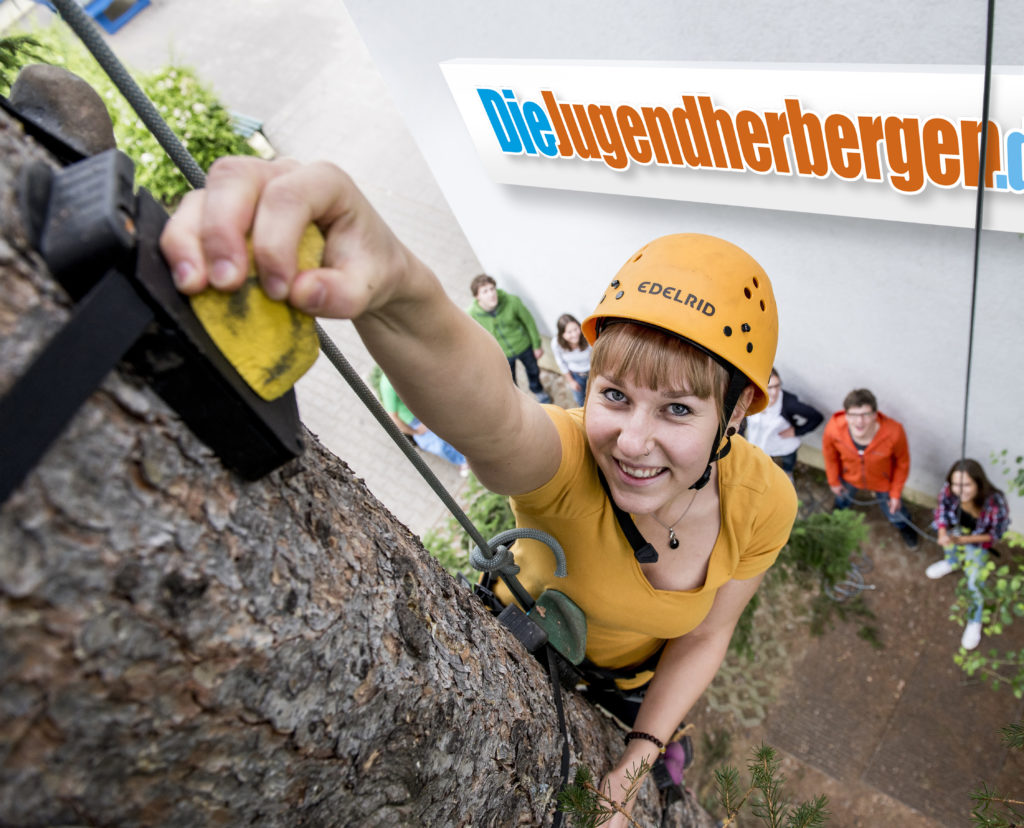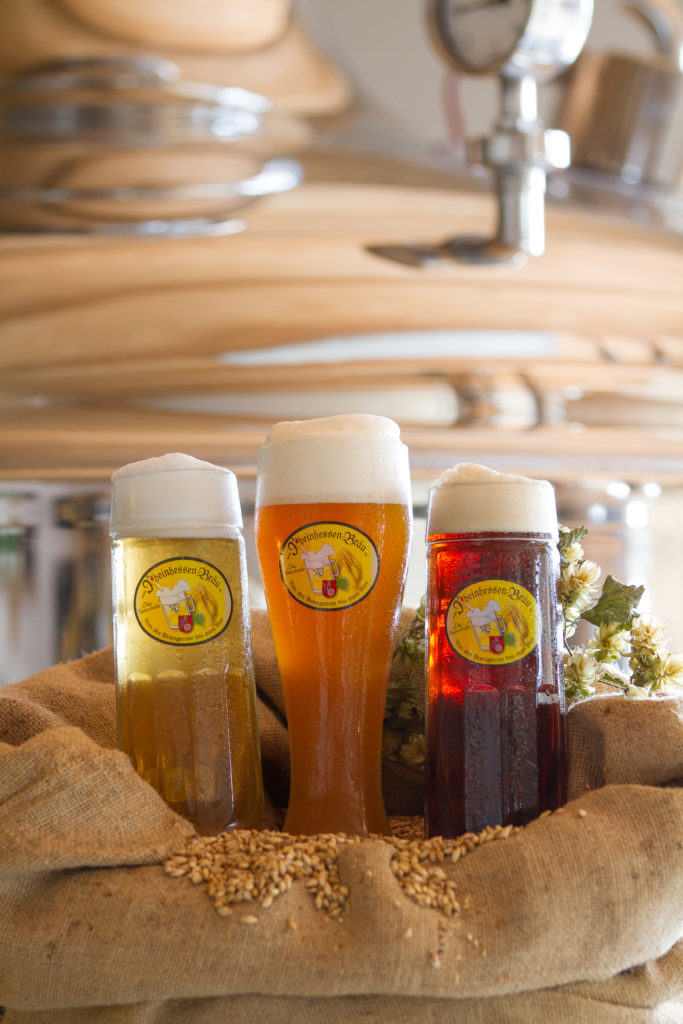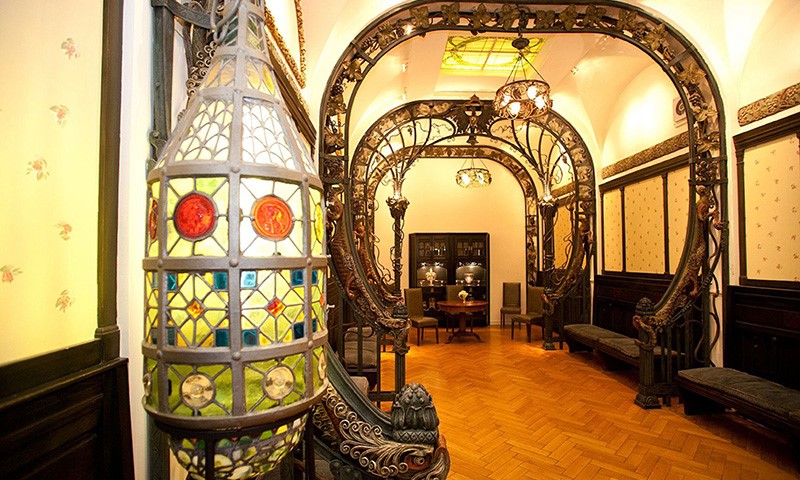Rheinhessen is Germany's largest wine-growing region and Rheinhessen's vintners produce many award-winning wines every year. Many thousands of years ago, the Romans already used the region's special terroir for their winegrowing. But not only wine has a tradition in Rheinhessen. In Alzey the curious can walk in the footsteps of the city's ancient art of brewing beer as part of a special experience tour.
In Roihesse they babble dialect
Even from a distance, we can see our expert for today, who will guide us through the history of beer in Alzey. In the garb of a medieval night watchman with halberd and cornucopia stands Marco Fitting already in front of the historic town hall of the city from 1587 and awaits our arrival. He greets us exuberantly in "Roihessisch" and we already realize that someone is burning for his job. "In Roihesse, they babble dialect!", Fitting gives us to understand. That's why the tour is generally offered in dialect - authentic and not mincing words, as will become clear later on.
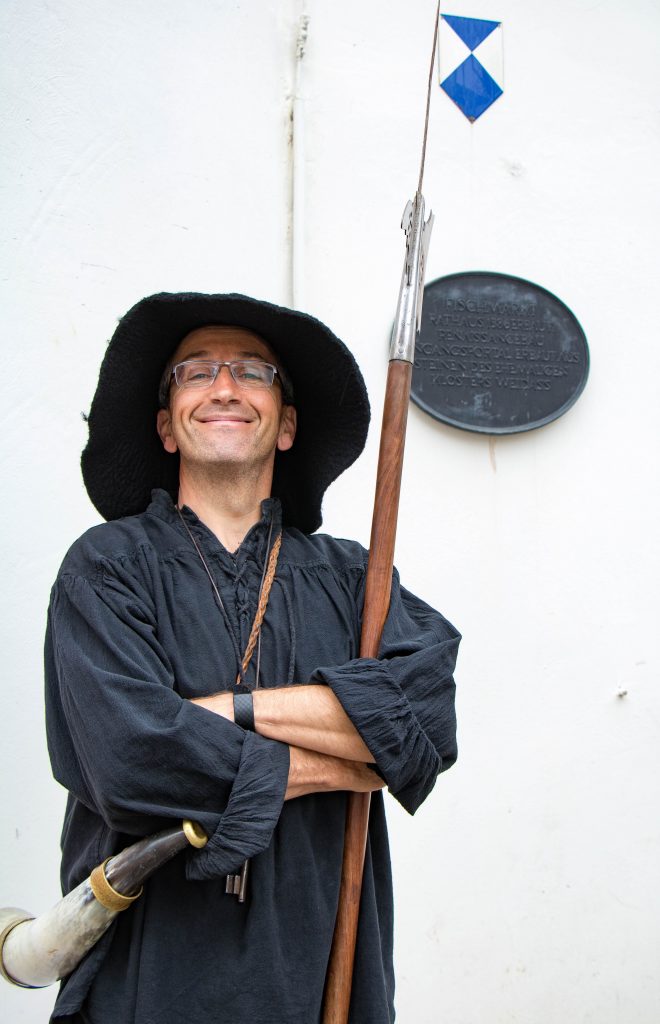
In early times, the town hall also served as a court and a a contact point for market traders. The Alzey double alley at the entrance of the town hall can still be admired as a standard measure and contemporary witness. In addition, the town hall kept town hall kept a record of every brewer. This was important at that time, because the purity law was issued in 1516, which had to be observed and monitored. and monitored. Nevertheless, some brewers tried time and again to gain an advantage by using tricks to gain an advantage. Sometimes hay was mixed in, sometimes the beer was beer with ox bile. When swindlers were found out, the entire full full barrels of beer were destroyed by knocking them out of the bottom. The still well-known saying "That knocks the bottom out of the barrel! comes from this "official act".
At weddings 14 breweries in Alzey
On our way to the Rossmarkt we learn that the first brewery in brewery in Alzey was mentioned in a document in 1575. At the height of the 17. century, there were 14 breweries and a large number of malt houses in Alzey, because beer was extremely important for the up-and-coming town. Alzey was already at that time administrative center, which meant that many people from the surrounding villages came to the city to the city for errands. They usually had a long day's journey behind them and stayed in one of the many inns. Beer was drunk as a staple beer was drunk as a staple food in the mornings - even by children. However this beer did not have much in common with what we know today. It was very thin and much less alcoholic, but it provided people with important nutrients and was not with important nutrients and - unlike well water - it was not pathogenic, since the brewing process killed all germs and bacteria. were killed. It was only in the evening that people at that time enjoyed a good and full-bodied draught beer, which we still call beer today.
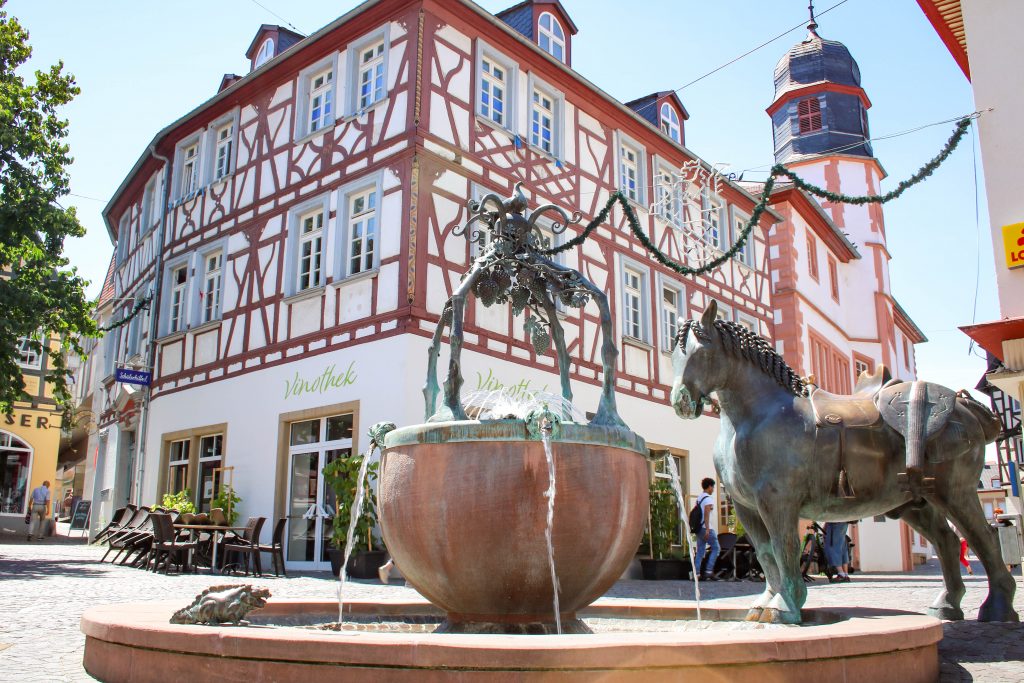
The Rossmarkt is one of the landmarks of Alzey. This is mainly thanks to the imposing fountain sculpture, which refers to the history of the square and is also supposed to represent the steed of the minstrel and knight Volker von Alzey from the Nibelungen saga. Designed by the Neustadt artist Professor Gernot Rumpf, the horse (called "Max") is a popular romping place for children, especially in summer, when they swing into the saddle and romp through the water feature. Attentive observers will spot a small mouse on the edge of the fountain. It is the artist's signature and is immortalized on all his works. As the name of the Rossmarktbrunnen suggests, in early times this was the home of the cattle market and the central market of Alzey. Also in the Rossmarkt located Rheinhessen Vinotheque a wine tavern must have already opened its doors in the middle age, which can still be seen by the old vine decorations in the half-timbering of the house.
In general, visitors to Alzey should take a closer look at the many the many half-timbered houses in the city. In many houses you can small (often white) hearts in the woodwork. What at first glance suggests a carpenter a very amorous carpenter, is nothing more than a kind of early "branding". kind of early "branding" or the trademark of a craftsman's business of the of that time, which can also be seen on many other half-timbered houses in the surroundings of Alzey.
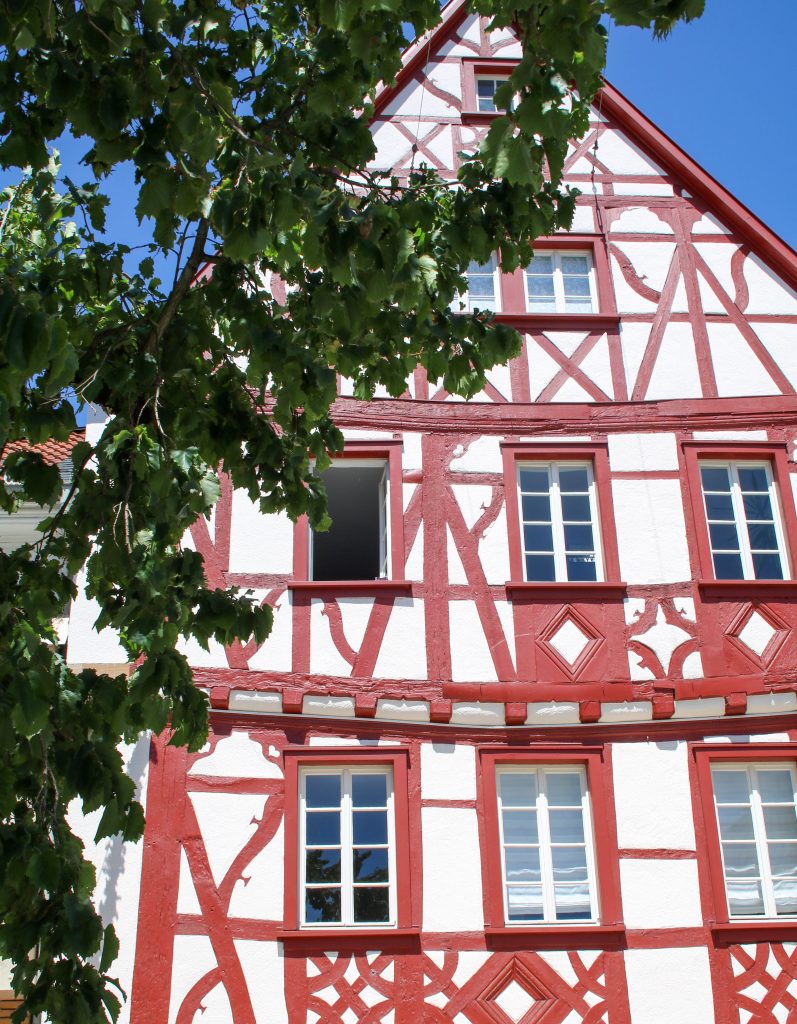
Decline of Alzey as a beer town
We continue to the former brewery inn Neidlinger, once one of the two largest breweries in Alzey. Here, too, we stand in front of a historical testimony of Alzey's decline as a beer town, and we ask our companion companion why almost all breweries in Alzey had to close. "That was lack of raw materials," Marco Fitting explains. Besides poor grain harvests, the scarcity of water in Alzey was the main reason why Alzey contributed to the fact that the breweries either moved out of the city to the waterfront or had to or had to cease operations altogether."
On the way to the "Hotel am Schloss" we stop at the briefly at the oldest inn in Alzey. The inscription on the beautiful dates back to 1579. "You can still eat and drink there today, but only on prescription! to eat and drink, but only on prescription!", jokes Fitting, referring to the and refers to the day clinic that has now moved in.
With a view of the "Hotel am Schloss", our guide now announces our city guide now announces another special feature of Alzey. During the U21 European Championship in Germany in 2004, the young team of the DFB was accommodated here in Mainz the young team of the DFB was accommodated here during the preliminary games in Mainz. Newcomers like Schweinsteiger and Podolski enjoyed Alzey's special hospitality. For local patriot Fitting, it is thus clear where the foundation stone for the for the team's subsequent victory in the 2014 World Cup.
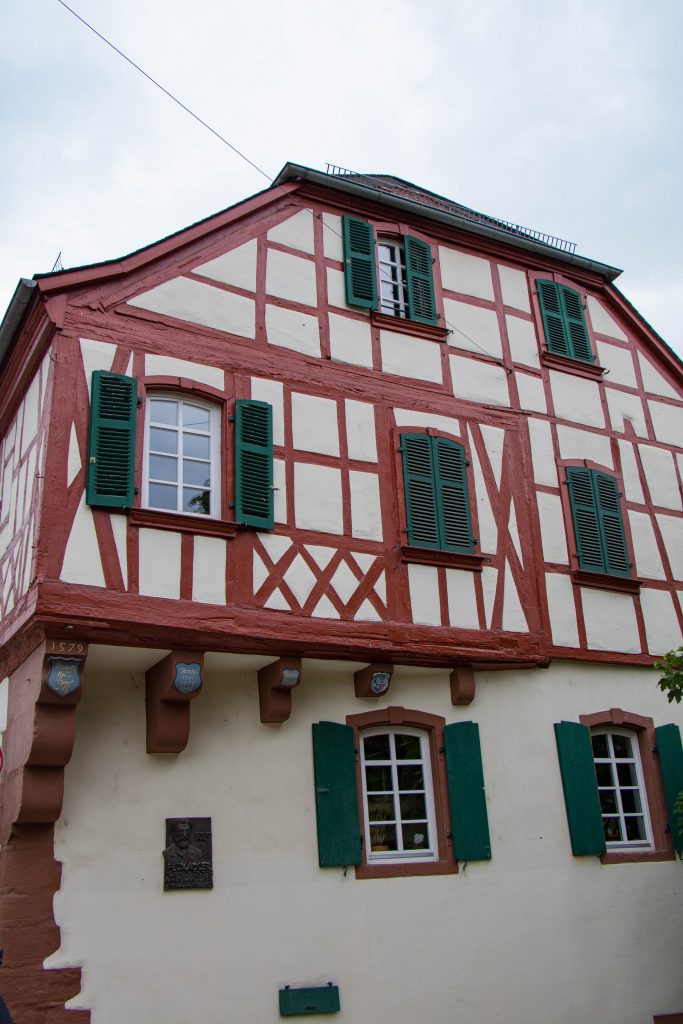
We continue through one of the many city gates of Alzey and change from the city to the castle district. At the city gate, an old iron that in the past a drawbridge protected the entrance to the city. protected the entrance to the city. Also the moat and the kennel are still preserved. At cellar, which we pass, we notice an unusual sign on the facade. facade. We recognize the contours of a knife, but no one can say exactly what the symbol is, no one can say exactly anymore. Was there a butcher here in the past or even a place of execution? "The knife doesn't look too sharp, does it? does it? Maybe they just used to make sandwiches here," says our medieval companion. bread," says our medieval companion, adding another variant. variant into play.
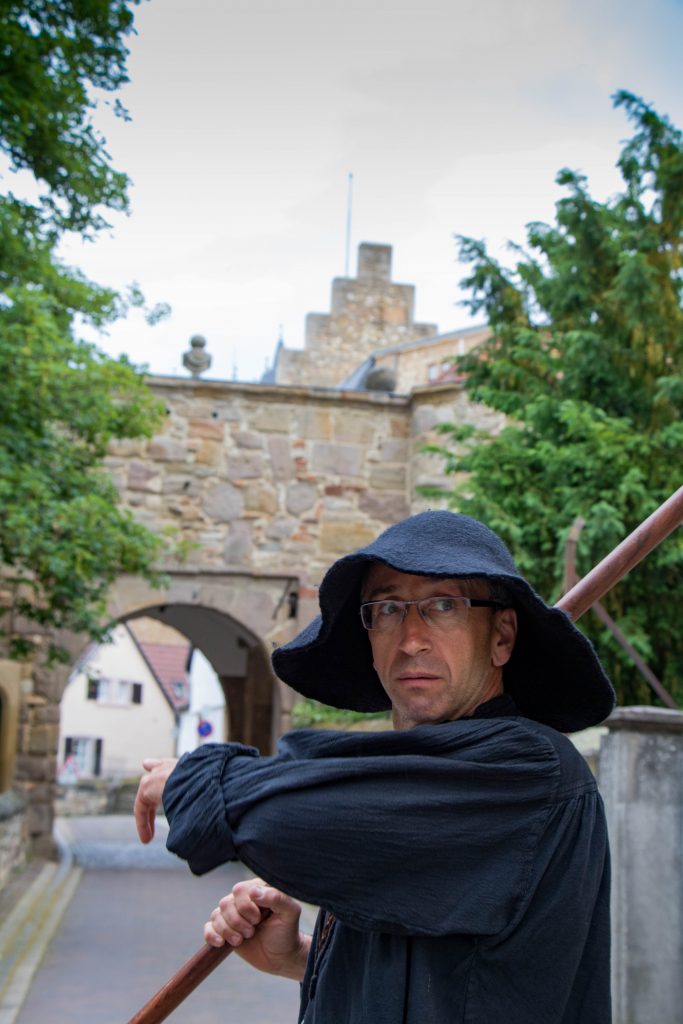
Beer tasting in Alzey castle
The impressive Alzey Castle, which we are now entering, has had an eventful history. Originally built during the Stauffer period (from 1125), it was completely destroyed in the turmoil of the Palatinate War of Succession in 1689 and then fell into a veritable slumber until it was rebuilt in 1903. Today, the walls house the local court and the boarding school for girls of the art high school. During the vacations, on the first weekend in August, the Alzey castle is the annual venue of the "Da Capo Festivals", which has become a true flagship of Alzey with its mix of comedy, pop music and classical music.
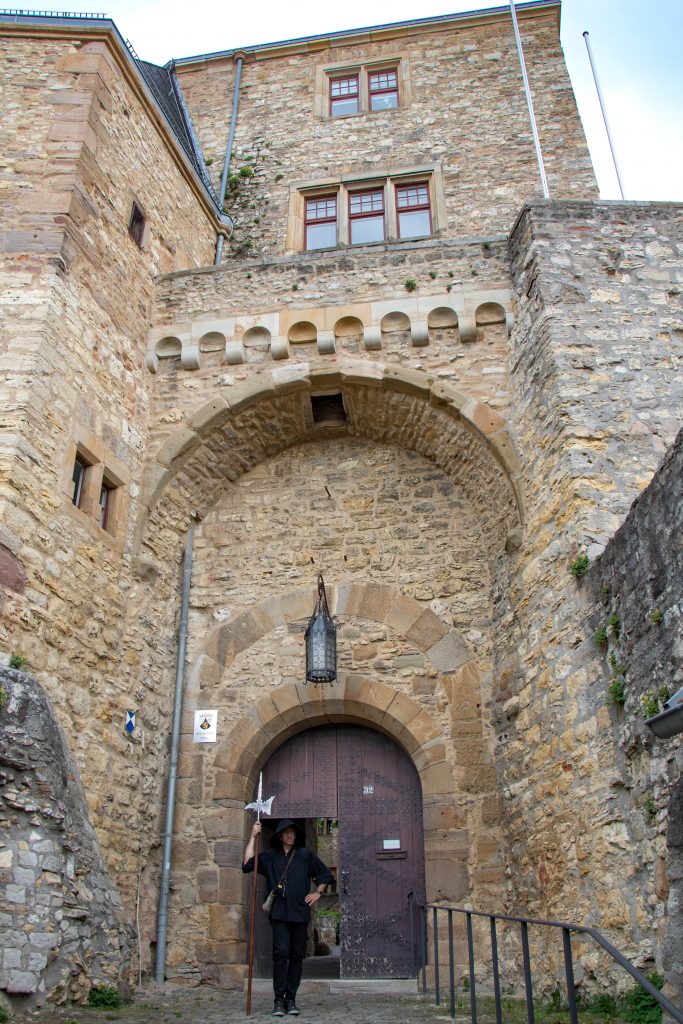
Under the old inscription "Großherzogliches Amtsgericht", which dates back to the time when the castle belonged to the Grand Duchy of Hesse, it is now time for our first beer tasting. Our night watchman disappears briefly behind the thick walls of the castle and then pours us a and then pours a refreshing sip of Alzeyer Volker-Bräu into specially designed 0.1l tasting glasses, which we can keep for the rest of the tour and beyond. and beyond.
The "Volker-Bräu" brand, named after Volker von Alzey from the Song of the Nibelungs, was originally created in 1915 by the merger as the "Genossenschaftsbrauerei Rheinhessischer Wirte" of the Kleinknecht and Neidlinger breweries, which were the largest in Alzey at the time. After the takeover by the Eichbaum Brewery in Worms, first the brand and then also the last large brewery disappeared in Alzey in 1935. It was not until 2006 that graduate brewmaster Dieter Birk started brewing beer again in Alzey under the brand name of "Volker Brew" to brew. The small brewery in Albiger Straße is thus the only one in Alzey that exists again today and offers beer lovers various seasonal specialties that can also be tasted and purchased on site.
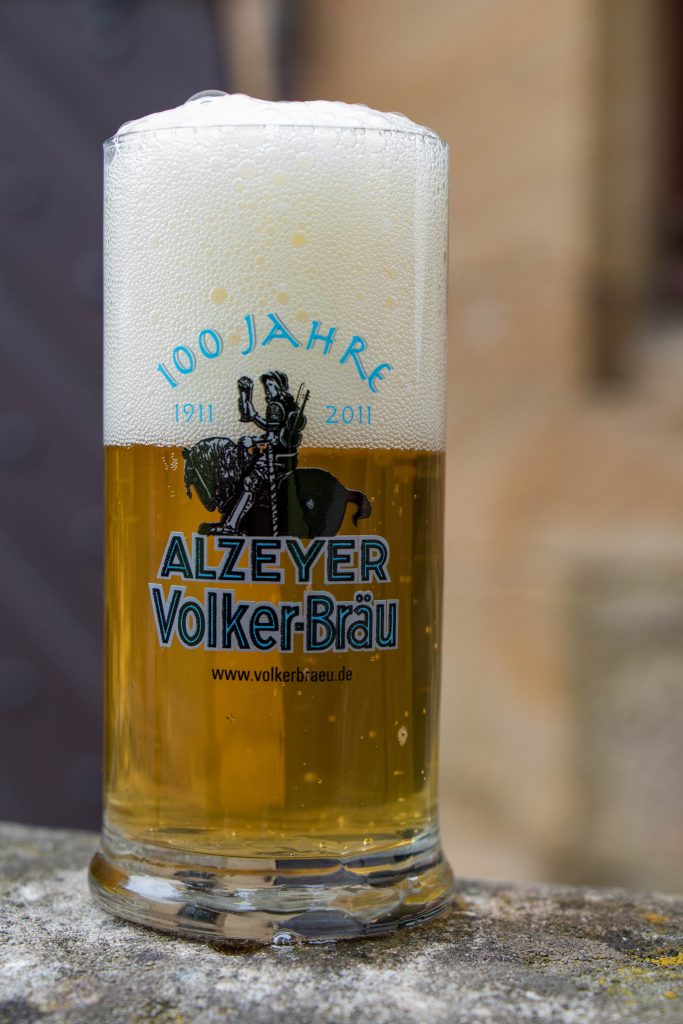
Evidence of the brewers' guild in Alzey
Thus strengthened, we leave the castle and walk past the former the former "12 Apostles Brewery", in whose dance hall many Alzeyer have learned to dance. Dark cobblestones on the ground give a hint of the the medieval course of the city wall. We are on the Kaiserstrasse. A memorial plaque in the ground reminds us of the former St. George's Gate, which controlled access to the city and was demolished by Napoleon in 1807. demolished in 1807. "When St. George's Gate was still intact, the landlord of the brewery inn, which was located outside the city walls at that time, had the key to the gate. So it sometimes happened that the gate was locked early in the evening early in the evening, and visitors arriving in the city had to wait in the inn for the for the next morning," our companion describes his enterprising fellow his enterprising fellow citizen from ancient times.
The tour continues past the former ice cellar of the brewery "Zur Kette". There you can still see the "Zoiglstern" on the facade, the old guild sign of the brewers. The hexagram symbolizes The hexagram with its six points symbolizes the most important fundamentals of brewing: fire, water and air as the important elements, and hops, water and malt as the basic basic ingredients.
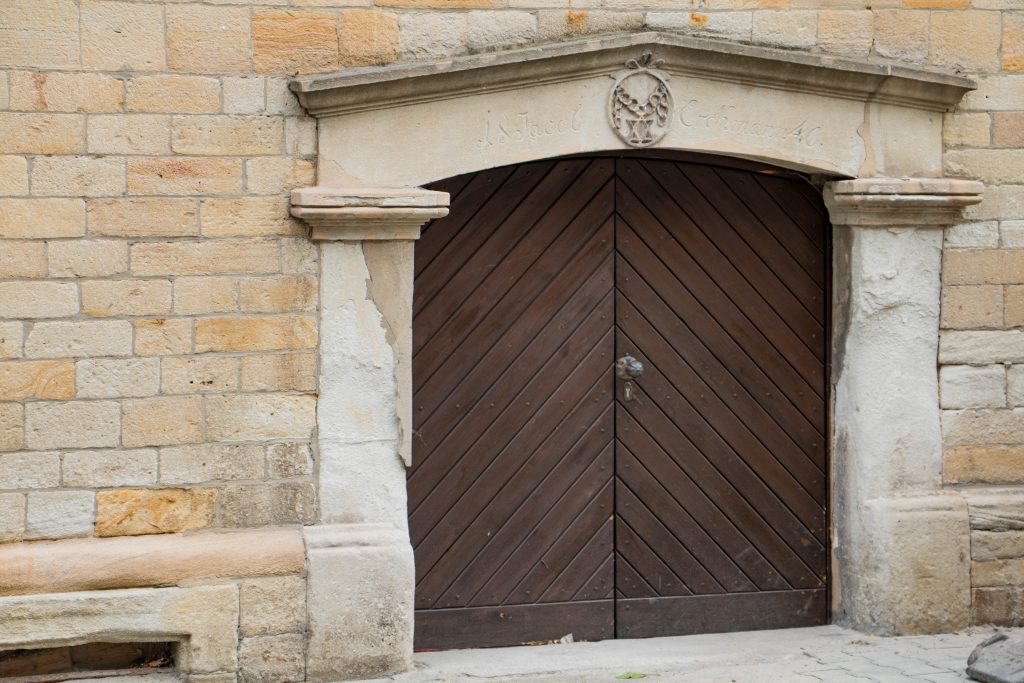
And already it's time for our second beer tasting. Arriving at the city wall with a view of the former ice cellar of the of the Prinz-Emil-Brauerei, we pull out our small glasses and from the improvised improvised depot, our beer expert conjures up a cool bottle of Volker-Bräu Bock beer. Sweet, quaffable and with a little more alcohol than normal beer refreshment and fortify ourselves for the last part of the tour. tour.
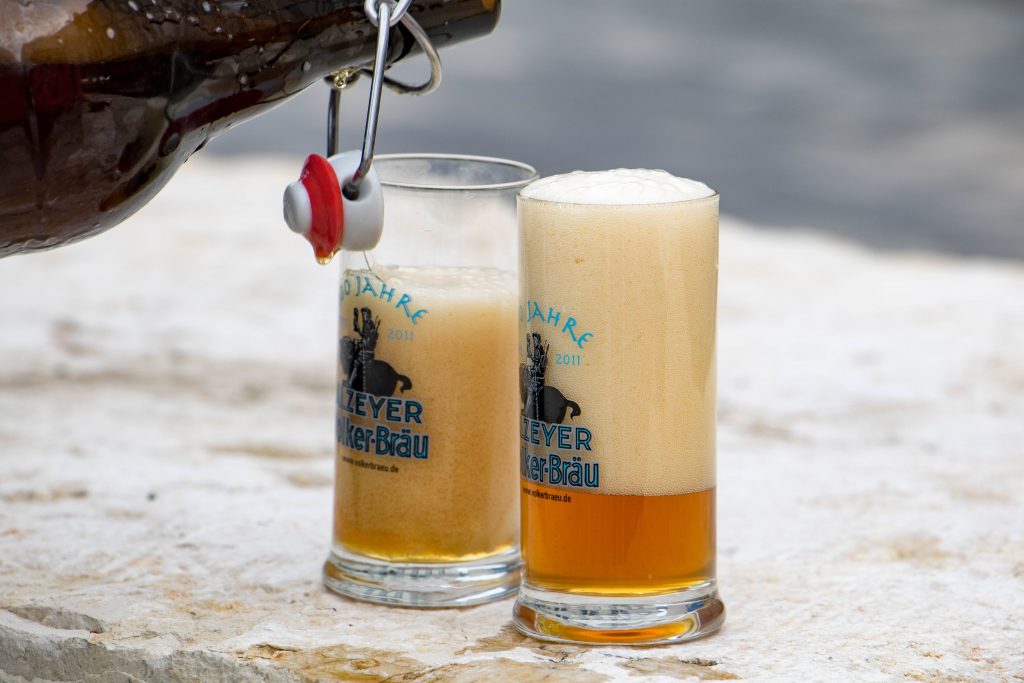
Along the closed Prinz-Emil-Brauerei, once the largest brewery in Alzey's largest brewery, we look down on the site of the likewise closed Bavaria Brewery. A rediscovered underground tunnel to the Selz once provided the important once provided an important water supply, which also supplied the town mill with water energy. with water energy.
Rue de Asskerb - où est-ce?
Through the narrow, winding alleys of Alzey, affectionately called by the locals affectionately called "Reilchen" by the locals as a phonetic phonetic remnant of the "Ruelle" (French for "alley") under the French occupation of French occupation of Rheinhessen, we take a shortcut. We end up in the "Arschkerb", as our companion remarks, when we leave the the narrow alley, whose exit is lined by two large buildings to the left and right, thus left and right, thus clarifying the anatomical designation. "The term, by the way, is not an invention of mine!" admits Marco Fitting admits, "in old Alzey official documents you can find the place name 'Rue de Arschkerb'. That's what happens when the Rhine-Hessian dialect meets the then French official language at the time," he smiles.
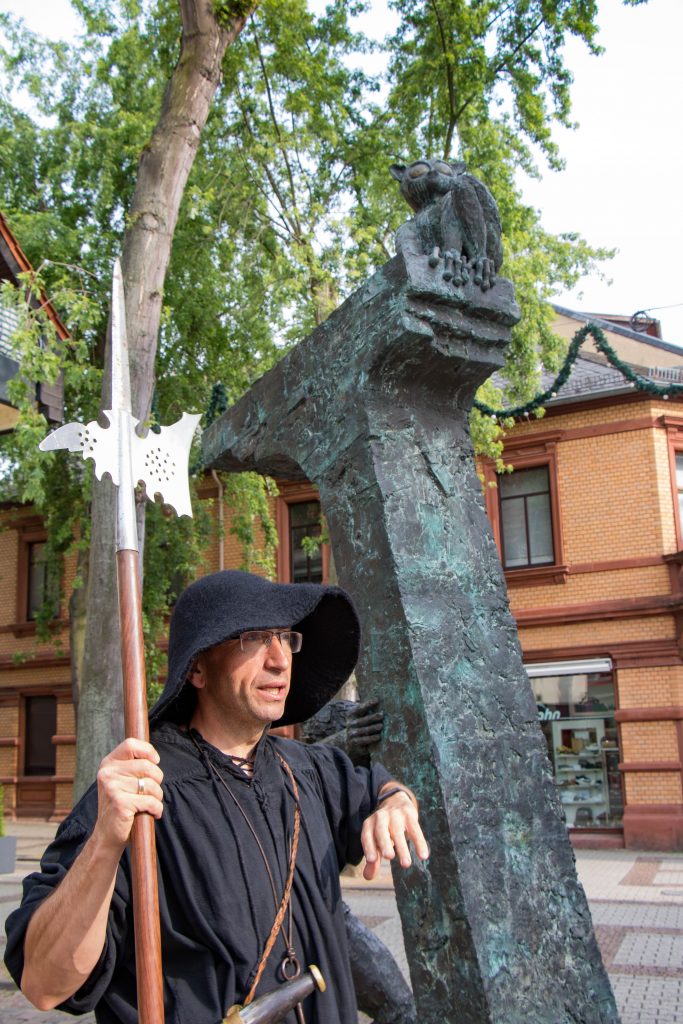
We pass the presumed location of the medieval Antonite Gate and now look from the "Denkmalschützer", a bronze figure symbolizing the Old Town Association, over to the former municipal hospital, which was built outside the city walls in 1580 because of the ever-present danger of epidemics in the Middle Ages. Since 1906 it has housed the Museum of the city of Alzey. The collection and exhibition focus of the museum is the cultural and natural history of the inner Rheinhessen. Visitors can explore prehistoric finds such as shark teeth, the skeleton of the manatee "Elsa" or the sea snail "Cerithium Weinheimense" as well as the prehistory and early history of Rheinhessen and the city and regional history.
Summer, sun, wheat beer
From the museum building our beer guide now fetches the third and last beer sample, which we are allowed to taste on the square in front of the museum. In keeping with the summer temperatures, a Volker-Bräu wheat beer awaits us at the end. Volker-Bräu wheat beer awaits us at the end. With its light banana aroma, it is a welcome refreshment refreshment before we set off on the last few meters of the tour.
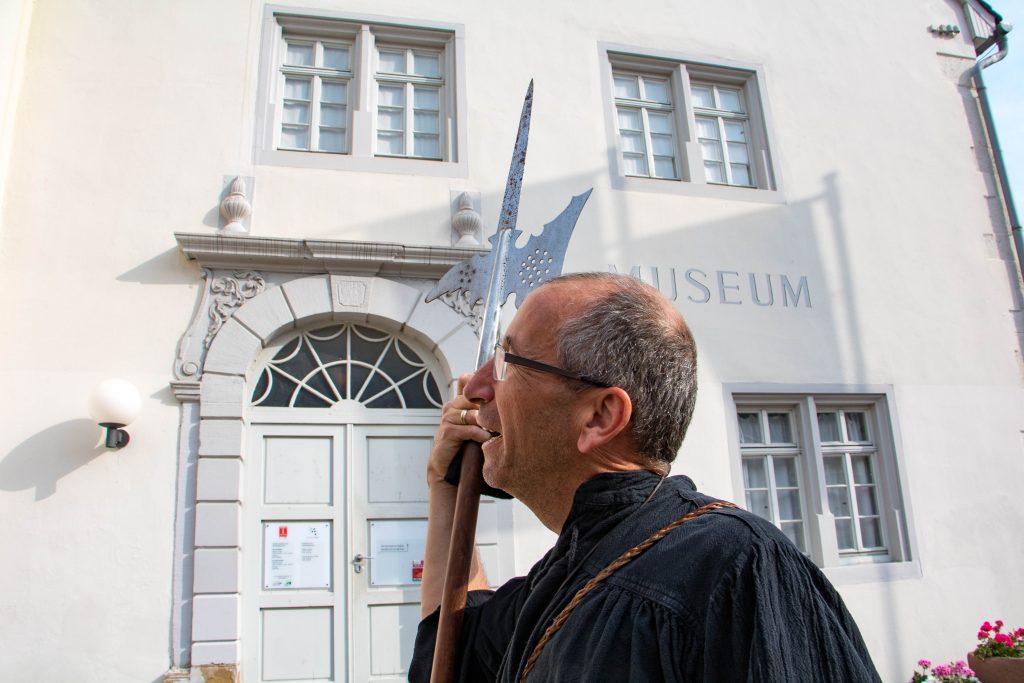
In front of the former premises of the Kronenbrauerei - across from the the museum - stands today the "Schnatz vom Kronenplatz", a bronze figure, which reminds of the former meeting place with kiosk, where the Alzeyer met and "babbled".
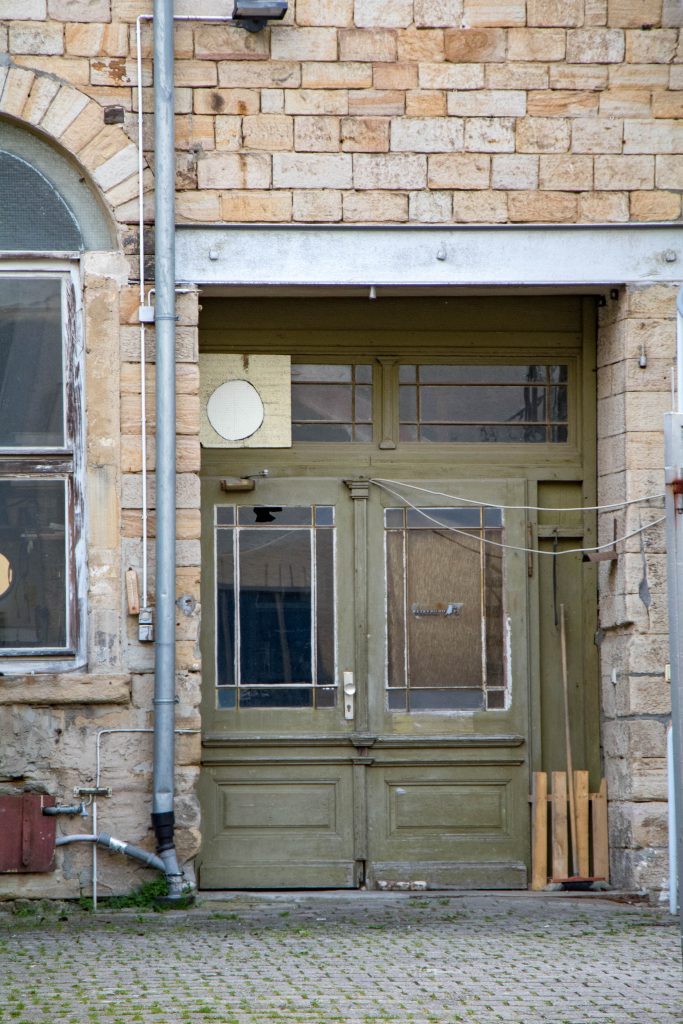
On our last meters up the Antoniterstraße we stop briefly we stop briefly in front of the area of the disused Germania brewery before our eventful and very informative tour ends today.
If you would like to stock up on a few bottles of Alzeyer Volker-Bräu for themselves or their loved ones at home, they can then then walk the few meters to Albiger Straße 7a. In there guest/seminar area can be booked on request besides brewing courses and beer samples for up to 30 people can be booked.
Would you like to walk in the footsteps of beer history in Alzey yourself? The costume tour "On the trail of the Alzey beer brewers" can be booked by interested parties directly at the Tourist Information Alzeyer Land be booked.

